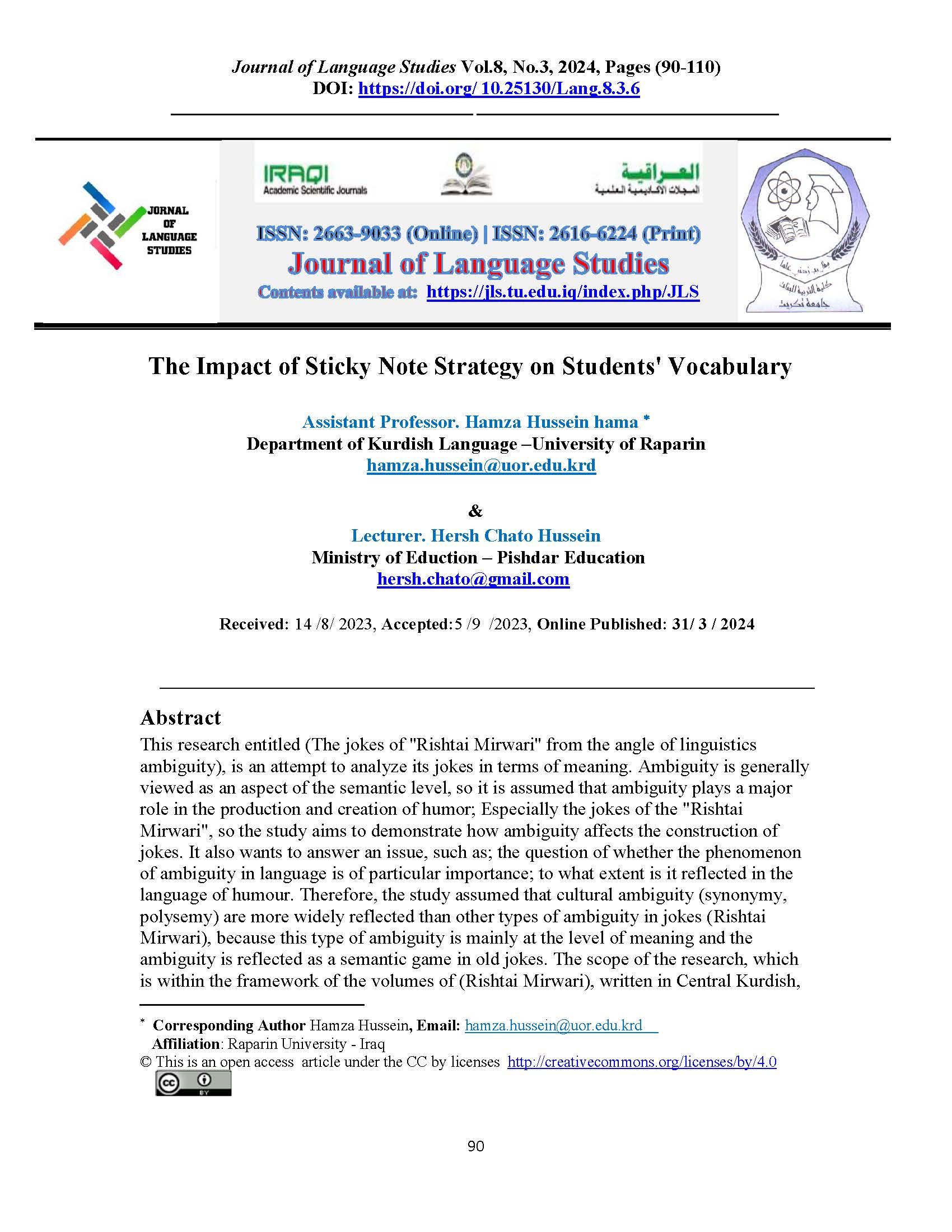The Impact of Sticky Note Strategy on Students' Vocabulary
DOI:
https://doi.org/10.25130/Lang.8.3.6Keywords:
Rishtei Mrwari, joke, Linguistic Ambiguity, Homonymy, polysemyAbstract
This research entitled (The jokes of ''Rishtai Mirwari'' from the angle of linguistics ambiguity), is an attempt to analyze its jokes in terms of meaning. Ambiguity is generally viewed as an aspect of the semantic level, so it is assumed that ambiguity plays a major role in the production and creation of humor; Especially the jokes of the "Rishtai Mirwari", so the study aims to demonstrate how ambiguity affects the construction of jokes. It also wants to answer an issue, such as; the question of whether the phenomenon of ambiguity in language is of particular importance; to what extent is it reflected in the language of humour. Therefore, the study assumed that cultural ambiguity (synonymy, polysemy) are more widely reflected than other types of ambiguity in jokes (Rishtai Mirwari), because this type of ambiguity is mainly at the level of meaning and the ambiguity is reflected as a semantic game in old jokes. The scope of the research, which is within the framework of the volumes of (Rishtai Mirwari), written in Central Kurdish, mainly relies on the method of (analytical-descriptive) statistics. Also, because much has been said about ambiguity in scientific research mediums, ambiguity has been discussed according to the needs of the subject.
is an attempt to analyze its jokes in terms of meaning. Ambiguity is generally viewed as an aspect of the semantic level, so it is assumed that ambiguity plays a major role in the production and creation of humor; Especially the jokes of the "Rishtey Mrwari", so the study aims to demonstrate how ambiguity affects the construction of jokes. It also wants to answer an issue, such as; the question of whether the phenomenon of ambiguity in language is of particular importance; to what extent is it reflected in the language of humour. Therefore, the study assumed that cultural ambiguity (Homonymy) are more widely reflected than other types of ambiguity in jokes (Rishtey Mrwari), because this type of ambiguity is mainly at the level of meaning and the ambiguity is reflected as a semantic game in old jokes. The scope of the research, which is within the framework of the volumes of (Rishtey Mrwari), written in Central Kurdish, mainly relies on the method of (analytical-descriptive) statistics. Also, because much has been said about ambiguity in scientific research mediums, ambiguity has been discussed according to the needs of the subject.
References
سەرچاوە کوردی و عەرەبییەکان:
١- وریا عمر امین (٢٠٠٤)، چەند ئاسۆیەکی تری زمانەوانی، بەرگی یەکەم، دەزگای چاپ و بڵاوکردنەوەی ئاراس، هەولێر.
٢- عەبدولمەناف ڕەمەزان ئەحمەد (٢٠١١)، ئەتڵەسی زمانی هەرێمی کوردستانی عێراق وەک نموونە، دەزگای چاپ و بڵاوکردنەوەی سپیرێز، چاپخانەی خانی، دهۆک.
٣- مەسعود بەکر ئەحمەد (٢٠١٥)، دژواتا و فرەواتا لە شیعرەکانی (گۆران) دا، نامەی ماستەر، زانکۆی سەڵاحەددین، کۆلێژی زمان، هەولێر.
٤- محمد علی الخولی (١٩٨٢)، معجم علم اللغة النظري، انكليزى عربى، مكتبة البنان، بيروت.
٥- ستيفن اولمان (١٩٩٧)، دور الكلمة في اللغة، ت: د. كمال محمد بشير، مصر.
٥- اف بالمر (١٩٨٥) ، علم الدلالة، ت: مجيد عبدالحليم الماشطة، مطبعة العمال المركزية، بغدا.
٧- كلود جيرمان و ريمو لوبلان (٢٠٠٦)، علم الدلالة، ت: د. نور الهدى لوشن، المكتب الجامعي الحديث.
٨- ئەوڕەحمانی حاجی مارف (١٩٧٥)، وشەی زمانی کوردی، چاپخانەی کۆڕی زانیاری کورد، بەغدا.
٩- ساکار ئەنوەر حەمید (٢٠٠٩)، وشە خواستن لە زمانی کوردیدا، نامەی ماستەر، کۆلێژی زمان، زانکۆی سەڵاحەددین، هەولێر.
١٠- بێخاڵ عەبدوڵڵا سەعید (١٩٨٩)، واتاسازی وشە، نامەی ماستەر، زانکۆی سەڵاحەددین، کۆلێژی ئاداب، هەولێر.
١١- عەلائەدین سوجادی (٢٠٠٥)، ڕشتەی مرواری، بەرگەکانی (١ ، ٢، ٣، ٤).
١٢- عەلائەدین سوجادی (٢٠٠٧)، ڕشتەی مرواری، بەرگەگانی (٥، ٦، ٧، ٨).
١٣- سەعید، یوسف شەریف سەعید (٢٠٠٦)، لێکۆڵینەوەی نوکتە لە ڕوانگەی زمانەوانییەوە، گۆڤاری زانکۆی سلێمانی، ژ.١٧، سلێمانی.
١٤- تابان محەمەد سەعید (٢٠١٤)، کێڵگە واتاییەکان لە ڕکێفەمەودای کۆمەڵەوە، نامەی دکتۆرا، زانکۆی سلێمانی، کۆلێژی زمان، سلێمانی.
١٥- دولبەر ئیبراهیم فەرەج شاڵی (٢٠٠٠)، نامەی ماستەر، زانکۆی سلێمانی، کۆلێژی زمان، سلێمانی.
١٦- فتاح مامە علی (١٩٨٩)، هاودەنگ لە زمانی کوردیدا، نامەی ماستەر، زانکۆی سەڵاحەددین، کۆلێژی ئاداب، هەولێر.
١٧- ڕۆژان نوری عەبدوڵڵا (٢٠١٣)، فەرهەنگی زمان و زاراوەسازی کوردی، چاپخانەی چوارچرا، چاپی دووەم، سلێمانی.
١٨- تاڵیب حسین علی (٢٠١٤)، هەندێ لایەن لە پەیوەندی نێوان ڕستە و واتا لە کوردیدا، چاپخانەی حاجی هاشم، هەولێر.
١٩- محمد معروف فتاح (٢٠١١)، زمانەوانی، چاپی سێیەم، چاپخانەی حاجی هاشم، هەولێر.
٢٠- سەباح ڕەشید قادر (٢٠٠٠)، هاوبێژی و فرەواتایی لە (گیرەک)دا، نامەی ماستەر، زانکۆی سلێمانی، کۆلێژی زمان، سلێمانی.
٢١- جون لاینز (١٩٨٧)، اللغة والمعنى والسياق، ت: عباس صادق وهاب، الطباعة والنشر دار الشؤون الثقافية العامة، العراق، بغداد.
٢٢- جون لاینز (١٩٨٠)، علم الدلالة، ترجمة: مجيد عبدالحليم الماشة واخرون، مطبعة جامعة البصرة، البصرة.
٢٣- شلێر رسول محمد (٢٠٠٤)، یاساکانی داڕشتنی لاڕستەی دیارخەری لە زمانی کوردیدا، نامەی دکتۆرا، کۆلێژی ئاداب، زانکۆی سەڵاحەدین، هەولێر.
٢٤- دارا حمید محمد (٢٠٠٦)، پێوەندییە واتاییەکان لە زمانی کوردیدا، نامەی ماستەر، زانکۆی بەغداد، کۆلێژی پەروەردە (ئیبن ڕوشد)، بەغداد.
٢٥- أحمد موختار (٢٠٠٩)، علم الدلالة، مكتبة عالم الكتب، الطبعة السابعة، القاهرة.
٢٦- محەمەد قادر محمدامین (٢٠٢١)، لێکدانەوەی پەیوەندییە واتاییەکان بەپێی تیۆری سیما واتاییەکان، نامەی ماستەر، زانکۆی ڕاپەڕین، کۆلێژی پەروەردە، ڕانیە.
سەرچاوە ئینگلیزییەکان:
- David Crystal) 2003), A dictionary of Linguistics and Phonetics, third edition, London: black well publishers.
- K. Horsy (2001), 101 Key ideas: Linguistics London.
- john Lyons (1977), Semantics, 2 Vols, London and New York, Cambridge University.

